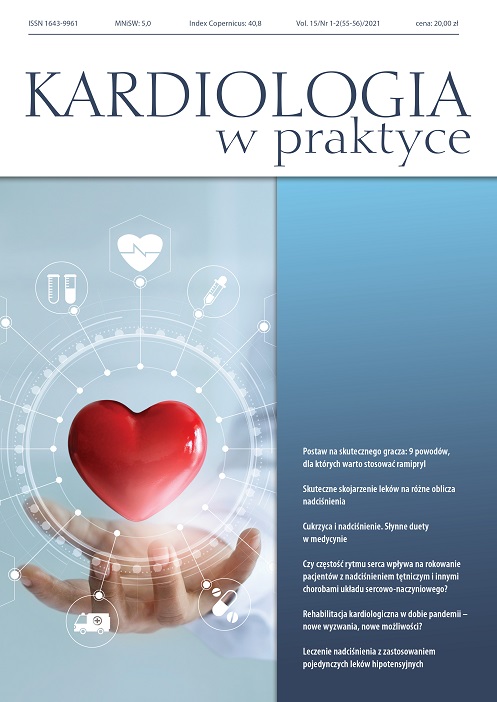Effective drugs combination for different faces of hypertension Review article
Main Article Content
Abstract
Hypertension is one of the most common risk factors for cardiovascular disease. It is estimated that every third adult suffers from hypertension all over the world. Hypertension occurs in over 10 million adult Poles and its frequency is increasing. Untreated arterial hypertension leads to numerous complications, including worsening of atherosclerosis, heart and kidney failure, and stroke. Awareness and treatment of hypertension is insufficient. Almost half of Poles do not know that they suffer from arterial hypertension. Of those treated, only ⅓ reach the target blood pressure values. Many factors influence poor blood pressure control, including low patients compliance, inappropriate drugs’ choice and underuse of single pills combinations. Currently, most patients need two or more drugs to control their blood pressure properly. Polytherapy often includes a drug that inhibits the renin–angiotensin system, and a diuretic. An example of such therapy is the use of valsartan and indapamide. Both drugs have proven antihypertensive efficacy and beneficial effects on prognosis.
Downloads
Article Details

This work is licensed under a Creative Commons Attribution-NonCommercial-NoDerivatives 4.0 International License.
Copyright: © Medical Education sp. z o.o. This is an Open Access article distributed under the terms of the Attribution-NonCommercial 4.0 International (CC BY-NC 4.0). License (https://creativecommons.org/licenses/by-nc/4.0/), allowing third parties to copy and redistribute the material in any medium or format and to remix, transform, and build upon the material, provided the original work is properly cited and states its license.
Address reprint requests to: Medical Education, Marcin Kuźma (marcin.kuzma@mededu.pl)
References
2. Williams B, Mancia G, Spiering W et al. Wytyczne ESC/ESH dotyczące postępowania w nadciśnieniu tętniczym (2018). Kardiol Pol. 2019; 77(2): 71-159.
3. Tykarski A, Filipiak KJ, Januszewicz A. Zasady postępowania w nadciśnieniu tętniczym – 2019 rok. Wytyczne Polskiego Towarzystwa Nadciśnienia Tętniczego. Nadciśnienie Tętnicze w Praktyce. 2019; 5(1): 1-86.
4. Liebson PR, Amsterdam EA. Ongoing Telmisartan Alone and in Combination With Ramipril Global Endpoint Trial (ONTARGET): implications for reduced cardiovascular risk. Prev Cardiol. 2009; 12(1): 43-50.
5. Fogari R, Mugellini A, Zoppi A et al. Effects of valsartan compared with enalapril on blood pressure and cognitive function in elderly patients with essential hypertension. Eur J Clin Pharmacol. 2004; 59(12): 863-8.
6. Julius S, Kjeldsen SE, Weber M et al. for the VALUE Trial Group. Outcomes in hypertensive patients at high cardiovascular risk treated with regimens based on valsartan or amlodipine: the VALUE randomized trial. Lancet. 2004; 363: 2022-203.
7. Levi Marpillat N, Macquin-Mavier I, Tropeano AI et al. Antihypertensive classes, cognitive decline and incidence of dementia: a network meta-analysis. J Hypertens. 2013; 31(6): 1073-82.
8. Guzik TJ, Mohiddin SA, Dimarco A et al. COVID-19 and the cardiovascular system: implications for risk assessment, diagnosis, and treatment options. Cardiovasc Res. 2020; 116(10): 1666-87.
9. Roush GC, Abdelfattah R, Song S et al. Hydrochlorothiazide vs chlorthalidone, indapamide, and potassium-sparing/hydrochlorothiazide diuretics for reducing left ventricular hypertrophy: A systematic review and meta-analysis. J Clin Hypertens (Greenwich). 2018; 20(10): 1507-15.
10. Wang S, Li J, Zhou X et al. Comparison between the effects of hydrochlorothiazide and indapamide on the kidney in hypertensive patients inadequately controlled with losartan. J Hum Hypertens. 2017; 31(12): 848-54.

